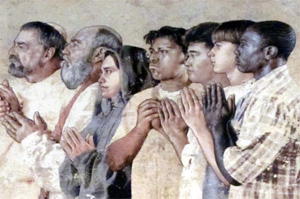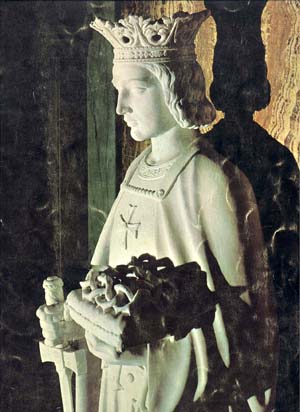 |
Art & Architecture
Where Have All the Real Saints Gone?
Marian T. Horvat, Ph.D.
Since Vatican II, progressivists have been trying to replace the idea of a hierarchical and sacral Church with the notion of the “people of God.” Even though the expression “people of God” can in fact be legitimately applied to the Catholic Church, there is an egalitarian tendency today to use this term to present the structure of the Church predominantly as a people - and no longer as a hierarchy. The Church as the people of God is the ecclesiological concept that Christ is “really present” only in the communities of the faithful.
“We are on a journey, on a pilgrimage, individually and as the People of God, away from darkness and sin to the saving light of Christ. Our cathedral design captures well that principle of spiritual journey,” said Cardinal Roger Mahony about the new Los Angeles Cathedral.

The L.A. Cathedral tapestry of the “people of God,” a parade of vulgarity alongside sanctity |
This is expressed in a tapestry that will line the cathedral wall, where the “people of God” also become a “communion of saints,” which also takes on a new meaning. Father Richard Vosko, public art consultant hired by Cardinal Mahony for his extravagant cathedral, give today’s common explanation that the communion of saints is present “whenever a church gathers to bless and thank God in the eucharistic liturgy .… After all, what is the church if not an assembly of saints. The Communion of Saints is the church” ("Tapestries of Faith,” The Tidings, 11/12/1999, pp. 14-15).
The “people of God as the communion of saints” is the theme of the immense tapestry work planned for the “poor” new Los Angeles cathedral. But the 133 “saints” who will appear on the tapestry are not traditional canonized saints, raised to the altar because of their heroic practice of virtue. They are the “everyday saints,” as the artist John Nava calls them, people of various ages and colors, lined up without distinction along with a few canonized saints like St. Peter and, of course, Mary Magdalen.
The flesh-toned figures draped in white togas all line an otherwise flat and undecorated wall. These figures will embody “the essence of the optimistic and life-affirming view of humans,” Nava said (ibid.). And so now, this expensive, modern cathedral will replace the traditional altars of the saints with this grand tapestry of the assembly of human persons, the everyday man. “We who are the church are also all saints,” the tapestry seems to announce, echoing the Protestant heresy on the very walls of a supposedly Catholic cathedral.
A final false note. The 700 yards of fresco-like tapestries will not be “real” tapestries. The depictions will be transferred via computer code in a color-by-number way onto thread that will be woven on giant looms to produce the “tapestries.” The computer-created images will allow the work to be finished in two years instead of the decade it would take if the tapestries were woven by hand. Thus, we now have false tapestries of false saints for a false cathedral. Not surprisingly, the price tag for this modern travesty is not small: the cathedral is estimated to cost the Los Angeles people of God close to $170 million.
For those of us who cherish memories of making little visits to side altars, setting requests at the foot of a favorite saint, making novenas and burning candles, this tapestry of “saints” is one of the most distasteful aspects of the new cathedral. Yes, the next generation of “feel-good” Catholics may feel very comfortable looking at the walls and finding young people who look just like themselves, but it will be impossible to develop devotions and supernatural relationship with this conglomerate of everyday people. Where will they find their patron saints, the personal links to heaven that draw it just a little closer to earth, the ideal models that nourish and cultivate heroism and sanctity?
The history of Christian Civilization used to be presented in the cathedrals by the lives of saints. The windows, statues and walls of the churches proclaimed that since the coming of Christ, the truly great men and women are the saints. Further, they were not heroes without any links to us; they were our intercessors and patrons. When a child was baptized, he normally received the name of a saint, who became his patron and model. Thereafter, he did not celebrate his birthday, but his saint’s day. When he grew up and entered a trade and guild, a new saint welcomed him. If he were a tanner, he had St. Bartholomew (who was flayed alive); for shoemakers there was St. Crispin, for beggars St. Alexis, for goldsmiths St. Eloy. At times the medieval imagination would stretch itself to embrace some favorite saint in charming ways: For example, the carpenters, whose work included making the tabernacles in which the ciboriums were placed, chose St. Anne as patron, on the grounds that she had made the first of tabernacles, the Blessed Virgin Mary who bore within her the Son of God.
Mary Magdalen, who had poured a jar of precious perfume over Our Lord’s feet, was patroness of perfume-sellers. St. Julian, who had not refused to receive lepers, became the patron of innkeepers. Kings had St. Louis IX and his cousin St. Ferdinand III, popes had St. Gregory VII and St. Leo the Great, and knights turned to St. George. Even the lawyers were able to find a model ideal, although the hymn sung in St. Ives’ honor reveals a good humored surprise that would surely be echoed today: Advocatus et non latro, res miranda populo (A lawyer and not a thief, A truly marvelous thing!)
The list could go on and on. Each region, each profession, every trade was represented by a saint deemed worthy to sit at the right hand of God. People were moved to admire and emulate the virtues, prayer life, exploits, and sacrifices not of the everyday man, but of men who were superior to the man of the street. The artists and sculptors who sought to represent them tried to show the different virtues on each face, to depict a soul, not a cold abstraction. It is no wonder that the figures of the saints fill so large a place in the traditional Catholic churches, why so many windows and side altars are dedicated to them. The people never tired of seeing their protectors and supernatural friends, for they felt on more familiar terms with them than with many of their own family and earthly friends. How many of our own pre-Vatican II churches were representative of this same spirit of intimacy and veneration.

St. Louis, King of France,
in the Cathedral of St. Louis, MO |
Consider, for example, this magnificent statue of St. Louis IX in the Cathedral of St. Louis in Missouri. St. Louis the King of France is first and foremost the great defender of the Church and the Catholic Faith. A magnificent model ideal for boys and young men who dream of wielding swords and fighting the enemies of Holy Mother Church in the Crusades. However, here he bears the Crown of Thorns, more precious to him than his own earthly crown since it was the crown worn by the King of Kings, the Savior of Mankind.
All his life, St. Louis had a special devotion to the Crown of Thorns and Passion of Our Lord. He built the magnificent Saint Chapelle in Paris to house three Thorns from the Crown Our Lord wore in the Passion. He knew well that the obligations of leadership were to be understood as sacrifice: to rule meant that he was obliged to carry the weight of the kingship and to always sacrifice his own personal tastes to represent the needs and desires of his subjects. Today we have lost the idea of this elevated conception of sacrifice. Many of our age assume that a man should place wealth and power at his own service and pleasure. This is completely different from the notion born from Christian Civilization in the Age of Faith.
Obviously, a man like Saint Louis was able to order the highest lords of France, but simultaneously he chose to serve the most humble of men, which he used to do once a year, when he personally used to serve at a table of the poor of Paris. This very Catholic tradition was called the Feast of Deposuit, in a reference to the Magnificat of Our Lady, when She sang: Deposuit potentes de sede et exaltavit humiles (He hath put down the mighty from their seat and exalted the humble). To rule was to serve, to embrace the Cross, and this model-ideal ever after remained for all earthly rulers.
Cardinal Mahony announced that his goal is to make a cathedral “that will last for 500 years.” I would suggest that he look to models from the past, the great magnificent cathedrals of Europe that have attracted and charmed Catholic souls for centuries. And, instead of a tapestry of everyday people, why not representations of the real saints whose lives still have meaning and can inspire the everyday man? These are not “dead” images of a superstitious past that need to be buried as the Church continues on her path of evolution in history, as progressivist theologians have proposed. No, indeed, for as the saying goes, there is more true life in the saints than in any other men.

|

More on this topic
 Cardinal Mahony's Controversial Cathedral Cardinal Mahony's Controversial Cathedral

Art & Architecture | Hot Topics | Home | Books |
CDs | Search | Contact Us | Donate

© 2002-
Tradition in Action, Inc. All Rights Reserved
|
 |
|